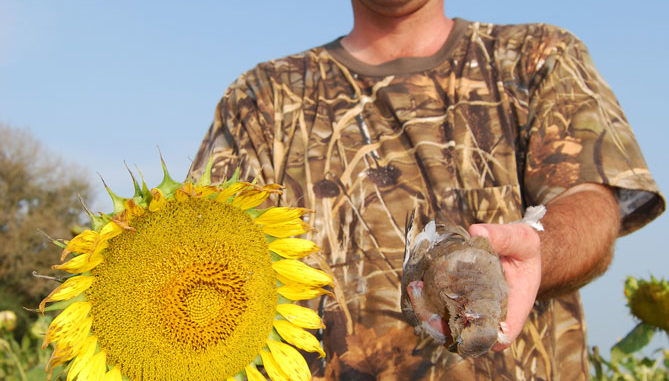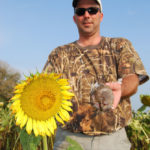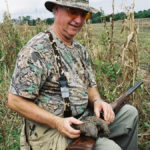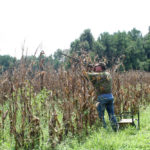
SCDNR plants around 50 fields on WMAs around the state specifically for public dove shoots.
“Mark!” “Bird!” “Bird, behind you! “Low bird, low bird, don’t shoot!” “Down the middle, high bird — nice shot!”
The sounds of a dove shoot are so familiar. Strangers become friends helping each other score on these elusive targets. Sharing the excitement of opening day in a dove field with 100 or so of your “closest friends” at one of South Carolina’s many Wildlife Management Area public shoots kicks off the wing-shooting season in high fashion.
Most of us would jump at invitations to fancy, private shoots, but we rarely if ever get them, so we attend public shoots. Frankly, even if we get an occasional treat, enthusiastic hunters still want to shoot doves more than a couple times a year, and in South Carolina — where public fields are beautifully prepared and managed by professional biologists and their staff — we have that luxury. The S.C. Department of Natural Resources sponsors safe and popular hunts in dozens of fields where hunters harvest tons of birds. Shooting a limit at these public fields requires timing, planning and a little luck.
Start by visiting the SCDNR website, www.scdnr.gov and look for information on public dove fields. Identify fields in your general area — say, anything within a 2-hour drive — and begin researching the specifics. To be most effective, you need the real skinny, so make an on-site visit, and just before opening day (Labor Day, Sept. 2) is a great time, since the attracting crops, often sunflowers and corn, are ripe, and the SCDNR staff has begun manipulating them for maximum bird holding. Later, during the season, phoning a Wildlife Management Area office will get you an assessment of their current conditions.
South Carolina staggers the “opening days” in WMAs, reserving several for youth-only hunts for the first day of the season and staggering the others to allow maximum participation and staff coverage. This affords those who have to work on opening day a chance at a fresh field and those with flexible schedules an opportunity to hunt multiple opening days. Through the rest of the season, most WMAs limit dove shooting to specific days.
According to Billy Dukes, small game project supervisor for SCDNR, 2012 was a was a good season, with a statewide average of 4.08 doves per hunter harvested on the opening day in the fields they monitor. “Any harvest above 4.0 doves per hunter is very good,” Duke said.
Of all the public fields, the four most productive were all draw-hunt fields where access is limited by a pre-season draw of applications posted before Aug. 15. The lottery draw hunts averaged 6.5 to 9 birds per hunter last year.
For lottery based hunts, the system changed to an electronic registration with a non-refundable fee to enter the drawing. The fee is much less than the returnable deposits of past lotteries. The deadline for entry into the lottery was Aug 15 so, for those not already registered for the drawing, the best areas last year that were not restricted hunts were: Dewitt in Darlington County, with 6.4 doves harvested per shooter, Santee Dam WMA in Clarendon County with 6.3, Piedmont Forestry Center in Oconee County at 5.9, Bordeaux Works in McCormick County at 5.7 and Webb in Hampton County at 5.2. Other very popular areas shoot lots of birds with lots of hunters but the averages are just not as high.
SCDNR dove shoots on WMAs and other public-access fields are done right. Of course, they have an advantage over most small landowners; they have lots of land, and they allocate adequate money, even from their stretched budgets, to one of their most-popular and well-attended shooting venues.
Both Dukes and Dean Harrigal, the manager of Donnelley and Bear Island WMAs, said crops look very healthy this year, and bird counts look good, indicating this should be a good opening week. The public fields for doves are planted and manipulated to encourage doves to visit and stay around. The preparation almost seems like cheating, but SCDNR carefully follow guidelines and game laws that specifically describe what is legal and what is not.
Most doves are hunted over one of three kinds of fields: harvested fields where normal fall crops have been combined and the residual grain has attracted doves; manipulated fields where crops were grown to attract wildlife; and freshly planted fields. Unlike farmers, SCDNR doesn’t harvest any crop except birds, which means their farming only supports the breeding and feeding of wildlife.
“Doves are not cheap,” Harrigal said. “Doves used to be easy. Every farm had them, and the deer were scarce.” That is no longer the case. Doves are still prolific breeders, but in areas where deer are thick, fencing dove fields is required or deer will eat all the grain. Most WMA fields in South Carolina are electric-fenced.
WMA fields are normally planted in alternating strips of wheat, sunflower and corn to provide food and cover throughout the season. The first planting, for the next year’s birds, begins with a drill-planting of winter wheat. A very important crop — one that is missing from many private fields — winter wheat is a bearded variety that deer won’t browse as heavily, that matures the next summer and forms the foundation for successful early season dove shoots.
The SCDNR’s goal is to stage successful opening day hunts in each of their fields, attracting every dove within a 10-mile radius during August and keeping them coming back until their “opening day.”
By July, when corn is growing rapidly and sunflowers are maturing, the wheat has fully matured, turned brown and is falling over. The first step of the “harvest” is an application of weed-killer to kill weeds that are still green and strong. When everything turns brown, they begin mowing the wheat strips to spread the seeds. It doesn’t take long for the word to get around among the dove population that there is easy food available.
The foundation crop of the early hunts is sunflowers that are planted from mid-April to late May. The small-seeded, black-oil variety are used because they makes more seeds and are heartier than the large-seed flowers. Sunflowers also mature before the season and are the main attractant in the early season. If given a choice in an early season hunt, set up overlooking the sunflowers.
The third crop in the rotation is corn. The large-kerneled, yellow cattle corn is planted is mid-March to April, to mature just as the season begins. In the early season, standing corn is used as much as hunter blinds as it is for a food source, but later, as the other crops are consumed, it becomes both blind and food. It is knocked down or “harvested” in stages as the season progresses.
Crop areas that get over-browsed, damaged or fail due to weather and other reasons are often replanted with brown top millet or dove proso millet, which are hearty, rapidly maturing and not very attractive to deer. Benne sesame is also used at times.
By the time opening day arrives, the wheat strips are gone, most seeds have been eaten, and the area was disked to expose free soil and any remaining wheat seeds. When hunters arrive, they see freshly cultivated soil where there was wheat, sunflower strips that are partially falling over and eaten by the birds and strips of corn that are ripe and upright, providing ideal hiding places.
The easy availability of food has done its job. All the local birds have discovered the area and keep coming back every afternoon. The crop maturation and harvest progression has hunters aiming at the plentiful birds flying unexpectedly into their dining area. Scores of hunters surround every WMA field and shoot thousands of shells at the darting doves. How good are the September opening hunts? At the one we attended last year, about 200 people shot about 800 birds. Those are impressive numbers, rarely matched by even the best private hunts.
When it’s all over, good shooters —and there are some great wing shots at the public shoots — have filled their bag limits, and the rest of us at least made a lot of noise and get to take a few doves home for the grill. It doesn’t get a lot better than this — except maybe at a traditional southern, private dove shoot, complete with after hunt libations.






Be the first to comment